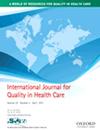Process management program to prevent falls in hospitalized patients with neuropsychiatric disorders: a quality improvement program
IF 2.7
4区 医学
Q2 HEALTH CARE SCIENCES & SERVICES
引用次数: 0
Abstract
Background: Falls were among the most common adverse nursing events. The incidence of falls in patients with neuropsychiatric disorders was high, and the occurrence of falls not only caused physical and psychological harm to patients but also led to medical disputes. Therefore, interventions for falls prevention were essential, but evaluations of the intervention process were lacking. Methods: In this study, a process management program to prevent falls based on the “structure-process-outcome” quality evaluation model was designed and applied to the clinical practice of falls prevention in hospitalized patients with neuropsychiatric disorders. The process quality evaluation checklist to prevent falls was used to supervise the implementation effect of intervention measures to prevent falls, identify the problems in the intervention measures, and make continuous improvements, to reduce the incidence of falls in such hospitalized patients as the final index. Results: The incidence of inpatient falls decreased from 0.199‰ (0.199 per 1000 patient-days) to 0.101‰ (0.101 per 1000 patient-days) before and after the implementation of the process management program for 12 months, 24 months, and 36 months, respectively, and the difference was statistically significant (P<0.05). The probability of falls was reduced by 49% after 36 months of monitoring. Furthermore, the proportion of patients at high risk of falls exhibited a downward trend. Conclusion: This quality improvement program was feasible and effective at reducing falls in hospitalized patients with neuropsychiatric disorders. Therefore, attention should be given to monitoring process quality in the management of falls.预防神经精神疾病住院患者跌倒的流程管理计划:一项质量改进计划
背景:跌倒是最常见的护理不良事件之一。神经精神障碍患者跌倒的发生率很高,跌倒的发生不仅对患者造成身心伤害,还会引发医疗纠纷。因此,预防跌倒的干预措施至关重要,但缺乏对干预过程的评估。方法:本研究设计了基于 "结构-过程-结果 "质量评价模型的预防跌倒过程管理方案,并将其应用于神经精神疾病住院患者预防跌倒的临床实践中。通过预防跌倒的过程质量评价检查表,监督预防跌倒干预措施的实施效果,发现干预措施中存在的问题,并持续改进,以降低此类住院患者的跌倒发生率为最终指标。结果显示流程管理项目实施前后 12 个月、24 个月和 36 个月,住院患者跌倒发生率分别从 0.199‰(0.199‰/1000 患者日)下降到 0.101‰(0.101‰/1000 患者日),差异有统计学意义(P<0.05)。经过 36 个月的监测,跌倒的概率降低了 49%。此外,高跌倒风险患者的比例呈下降趋势。结论这项质量改进计划是可行的,并能有效减少住院神经精神疾病患者的跌倒。因此,应重视跌倒管理过程中的质量监控。
本文章由计算机程序翻译,如有差异,请以英文原文为准。
求助全文
约1分钟内获得全文
求助全文
来源期刊
CiteScore
4.90
自引率
3.80%
发文量
87
审稿时长
6-12 weeks
期刊介绍:
The International Journal for Quality in Health Care makes activities and research related to quality and safety in health care available to a worldwide readership. The Journal publishes papers in all disciplines related to the quality and safety of health care, including health services research, health care evaluation, technology assessment, health economics, utilization review, cost containment, and nursing care research, as well as clinical research related to quality of care.
This peer-reviewed journal is truly interdisciplinary and includes contributions from representatives of all health professions such as doctors, nurses, quality assurance professionals, managers, politicians, social workers, and therapists, as well as researchers from health-related backgrounds.

 求助内容:
求助内容: 应助结果提醒方式:
应助结果提醒方式:


